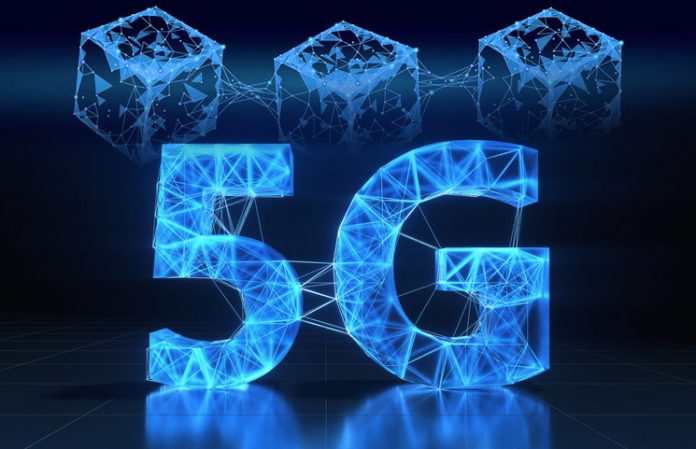5G technology has been at the forefront of countless discussions. But there's simply no denying that is has all the potential to shake up business and propel industries forward into new territory. It's introduction would have an immediate, and positive impact on a internet communication, digital communication and the field of commerce, beyond any doubt.
In increasing the speed and strength of internet connectivity, 5G would fuel a massive rise in the use of artificial intelligence, Augmented as well as Virtual Reality for businesses all over the world. In doing so, making businesses and our world operate in a faster, more advanced way than ever before.
But one of the innovations that it could have a profound impact on, interestingly, is blockchain technology.
This impact is more than simple speculation. Industry experts argue that 5G technology, when combined with the already emergent blockchain tech, has all the potential to yield benefits on a global and, as of yet, unparalleled scale.
While 5G on its own could easily fuel the already powerful world of micro-payments, the combination of blockchain and 5G could take digital and micro payments to a whole new level.
Again, this is far more than just theory. Qualcomm's President – Cristiano Amon – for example believed that 2020 would be the year when 5G technology become ubiquitous in metropolitan regions, before going wholly mainstream in the exact same year. 5G, Amon, concludes, will become globally recognized by 2021, with phone companies anticipating hundreds of millions of 5G smartphone orders over this same year.
With 5G expected to take the world by storm in 2020/21, it also has all the potential to propel blockchain and its underlying Distributed Ledger Technologies (DLT) along with it. It's when we read deeper into just what 5G can bring to the table that we realize just how it can become the biggest and best thing to happen for blockchain technology.
See the Number One Blockchain Investment of the Decade
Contents
5G Technology Set to Enhance Greater Connectivity in Developing Countries
More and more people all over the world have, or are obtaining access to smartphones, at a staggering pace. This growth is more than just a developed world phenomenon; with countries like China, Malaysia, Indonesia, Brazil and Mexico all seeing exponential growth in smartphone penetration.
There is still work to be done in order to widen this door to smartphone use, however. Countries like China and India are still on the lower side of smartphone use: standing at 58% and 24%, respectively. Those that don't have access to smartphones, alternatively, rely on older mobile phone model, which freezes them out of all the utility of the former. This factor means that they have otherwise missed out on the cryptocurrency, mobile and blockchain revolutions that we, in the developed world have been exposed to.
There's an opportunity emerging within these emerging markets, however. More people, for example, have access to a phone or smartphone as their primary means of accessing the Internet: which is fast becoming the most popular means of doing so.
Introducing 5G technology to the developing world as a market means that smartphones can be made far cheaper, while granting greater autonomy to individuals than ever before.
Mobile Payment Networks Are Coming to Develop World Wide Communication
Mobile payments are the new and popular trend among emerging markets, and it's something that blockchain and cryptocurrency projects are very reticent of. CoinTelegraph, for example, reported on the rapid rise of M-Pesa – a mobile payment service that made the rounds and became a digital payments mainstay in Kenya.
Having initially been launched back in 2007, M-Pesa is a mobile payment solution that offers compatibility to a wide array of smart and older mobile phone models. Since its launch 13 years ago, more than 96 percent of Kenyan households have reported that they have at least one person in their family that uses it. This fact is a game-changer for those that would have otherwise lived in poverty; offering them unprecedented financial autonomy.
Over the past 13 years, M-Pesa has actually seen a marked increase in the average household income of Kenyans using their service; boosting them by more than 30 percent over this period of time.
Vodaphone, the parent company behind M-Pesa stated within a press release from 2017, that M-Pesa is “the world’s leading mobile money service”. The description seems appropriate, considering the fact that M-Pesa consists of over thirty million active customers, while processing 614 million transactions on a monthly basis, equaling 529 transactions every second.
So why are we talking about M-Pesa? It's quite simple, honesty – M-Pesa is just one example of how much of a feverish demand there is for mobile payment services to plug the gap where conventional banking is otherwise unavailable. Providing a service that is otherwise highly accessible to people within a developing market spells a recipe for spectacular success.
While the Kenyan population has not been able to embrace cryptocurrencies like Bitcoin, or mobile banking apps, simply due to their relative inaccessibility. This is what sets M-Pesa apart; thanks to its decision to work with the technology of the region.
This is where 5G technology comes in. As it makes its presence known in Kenya, it will allow this same population to embrace the same innovations that we, in the developed world, have had for a decade now.
For the world's unbanked population – this is an incredible triumph. With 2 billion people across the world lacking access to a bank account. 5G technology, in tandem with blockchain can give these same people access to these services on an unprecedented scale.
How Blockchain and 5G Help Secure Mobile Banking's Future
5G and Blockchain technology combined have all of the ingredients to set the world of banking on fire; allowing for unparalleled coverage, internet accessibility, and security in one partnership. At this moment in time, banks have already been, or have, transitioned to using some form of DLT or blockchain solution for security, and that's no real surprise.
Distributed Ledger Tech allows for easy and highly secure authorization for transactions on a high scale without any need for a centralized, overarching authority to permit it. DLT decentralization has an added benefit too. If a bank's central servers were to become compromised or inaccessible, it would have no impact on the end-user, as the underlying DLT would still process and maintain a ledger of transactions that took place in the interim.
A combination of 5G technology and blockchain would manage to make an already impressive system even more impressive for the end-user, according to Richard Dennis. The CEO and founder of TemTum, Dennis explains that:
“Blockchain can secure mobile banking networks that will have to secure transactions on a very granular level, while 5G itself will make sure these complex networks don’t strain under the weight of blockchains.”
“If crypto networks can deliver payments solutions to these populations, it will be a major stride forward for both the unbanked and underbanked.”
How Will 5G WiFi Enhance Blockchain-Based Cryptoassets?
Mobile manufacturers, communications and service providers are understandably optimistic about the implications of 5G technology, and it's hard to blame them. In total, companies in this industry expect 5G to provide them, and their customers:
- Reduced communications and internet latency
- Improved data rates (lower potential costs)
- Reduced costs on energy
- Broader reductions in cost
- Enhanced systems capacity
- And substantially improved connectivity
Every single one of these benefits has the ability to really improve conditions for using blockchain, DLT technology as well as cryptocurrencies worldwide. In the space of just 1-2 years, mobile accessibility, communications and financial autonomy for developing nations would be made far easier, far cheaper and far better for users and businesses worldwide.
5G would also provide exceptional dividends for the likes of Internet of Things (IoT) which, in turn, would allow for blockchain technology to go further than ever. These innovations could also benefit from a number of unique features characteristics of blockchain such as its encrypted security, decentralization, immunity to attack and malware as well as systems of consensus creation and arbitration within its foundational layers.
This reciprocal dynamic between these innovations would make the prospects of driverless cars, smart homes, buildings and cities are far more likely and effective prospect. With all of it being built on a revolutionary 5G-powered blockchain framework.
One of the demands that do come with leveraging blockchain is the fact that it requires a considerable amount of network capacity in order to effectively function. 5G technology proves more than capable of providing the capacity for blockchain in order to operate, thus making it far more feasible wherever 5G is in operation.
One of the net positives of 5G technology also lies in the fact that higher network capacity and throughput means that block times can be cut down significantly, allowing for those using blockchain to scale easily. 5G also adds to this matter of functionality by improving node participation and enhancing decentralization.
See the Number One Blockchain Investment of the Decade
5G Technology As a Catalyst for Scaling Blockchain Functionality
A lot of the improvements that can be made to blockchain, thanks to the use of 5G technology, inevitably come down to scalability. And considering the chronic challenges that blockchain has faced on account of scale, that's an incredible breakthrough. To date, it has been the single, seminal problem beguiling the continued application of blockchain. While it offers exceptional security and reliability, scale is what really hamstrings it.
One of the most prominent examples of the challenge that scale represents comes from transaction speeds. While Bitcoin and Ethereum have made headway in addressing scale, their transaction speeds (4.6 and 15, respectively), simply cannot compare to the kind of scale that major financial entities are used to dealing with. MasterCard, and Visa as just two examples, are set up to deal with 45,000 and 1,700 transactions per second.
While other cryptocurrencies and blockchains have set themselves up as faster alternatives, they still remain in the dust of major financial entities. The implementation of 5G into this space would allow for a digital B12 shot, with 5G offering speeds of over 10 Gigibits per second.
With any solution to scale, so too comes a solution to capacity bottlenecks. 5G could offer a long-lasting solution to needs for capacity and transaction speeds, all while cutting down latency. Introducing 5G technology to the ecosystem of blockchain would offer a solution to its latency and scalability issues, while improving node participation and cutting down on the time it takes to process blocks. In summary, 5G technology would offer the means by which to organize a network of blockchain nodes.
5G For Boosting Smart Contracts Plausibility
Smart Contracts have gained popularity among users thanks to the benefits it can provide for users from individuals to multinational business. 5G technology also has the potential to make smart contracts far more usable to businesses worldwide than ever before.
To provide some context – Smart contracts and their performance hinge upon oracles, which serves as data feeds, relaying information to the associated smart contract. In order to make this system practicable, these oracles need constant access to the Internet in order to send and receive data. With the expansion of 5G technology worldwide, the implementation of oracles and smart contracts, by extension, would be made far easier, even in remote areas.
5G to Increase Full Node Capacity, Improving Blockchain Networks
Along with improvements to scale, transaction speeds and smart contract usage, 5G technology also offers the potential for massive increases in reductions to latency, as well as dramatic improvements to bandwidth and overall range. What this means is that public blockchains can play host to a far higher number of nodes, thus improving its speed, overall.
Through extending coverage, and enhancing the level of network connectivity for smartphone, mobile and tablet users, 5G would allow for far greater network participation. Enhanced participation means more nodes active, and more nodes means dramatically enhanced security and far greater levels of decentralization.
Bitcoin has faced its fair share of criticism on account of its distribution of nodes. These criticisms stem from the fact that a large proportion of its mining pools and majority of its nodes reside in China. What this means is that the voting majority of Bitcoin's network resides in China as well, which rings of a little too much danger for some.
With the introduction of 5G technologies, this problem of nodes would be resolved and eliminated as a prospective issue, thus making it easier to, not only diversify blockchains, but democratize them worldwide.
Cisco Granted a 5G Blockchain Patent
From what we've discussed here, it's no surprise that there are a litany of benefits that come from a collaboration between 5G and blockchain, there are some future practical applications. Cisco, the international technology company, back in November 2019, received a patent which explained how it would go about leveraging this combination of blockchain technology in tandem with 5G innovation.
The California-based business went about submitting the patent as far back as June 2018. Cisco has since announced that it would look to use the platform in order to manage data between equipment users such as phone or laptop users, and its virtual network.
To put it more briefly, Cisco's patent would ultimately allow for efficient data exchanges between the underlying network, as well as a connection device such as blockchain. It is made abundantly clear that Cisco sees a distinct potential between 5G and Blockchain technology, seeing a way in which the two technologies could easily work in tandem.
Will 5G Compromise Blockchain Technology's Potential?
Now that we've listed a number of reasons why 5G technology could easily benefit blockchain technology. The question must be put out of whether there is any proof to show that 5G technology could actually harm blockchain? Of course, there are some prospective downsides with this kind of collaboration.
There is always the possibility that malicious devices and entities could enter the network and cause chaos, as a result. This is an inevitable by-product of increased interconnectivity, however. With malicious entities being able to abuse public, unconnected networks.
One of the potential challenges, as opposed to downsides, is the prospect that, even with the introduction of 5G, that demand for cryptocurrencies and blockchain may place a disproportionate amount of demand on these networks, leaving these networks with a lack of scale with which to keep up.
In Conclusion
Mobile telecomms and businesses in the space of smartphones are understandably excited about all of the potential and opportunities that come with 5G technology. The combination of 5G with blockchain technology has all of the potential to be a tremendous leap forward for businesses and individuals all over the world.










